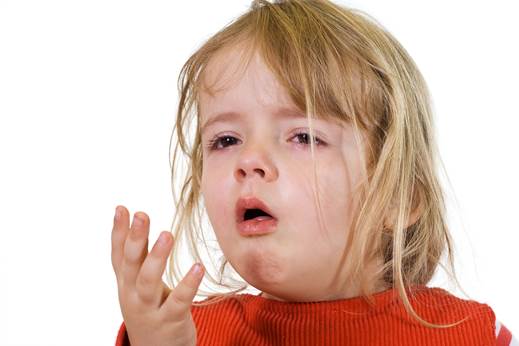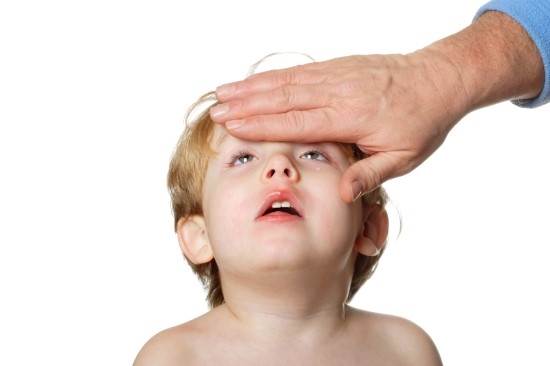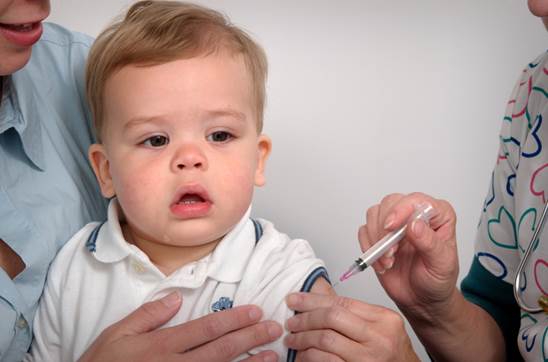According to The American Medical
Association’s statistics, an adult can have respiratory infection for 2-4 times
per year. Children’s risk of respiratory infection is much higher than adult’s.
Children who have normal nutrition state
and growth can have upper respiratory tract infection over 10 times a year. The
upper respiratory tract infection is acute infection in the respiratory tract,
and caused by the intrusions of factors, such as viruses (influenza, Pare-
influenza, adenovirus, rhinovirus, Coronavirus, enterovirus, RSV…) or bacteria
(streptococcus pneumonia Heamophilus influenza, B.catarrhalis, streptococcus
pyogenes…)
Causes

The
chance having diseases will increase if the children live in areas that are
polluted.
Children have disease by the time they
contact with the fluid that contains viruses or bacteria and is got out by the
patient’s sneezes or cough; it also happens when children hold toys or items
that have pathogenous factors. Premature or light-weight children or ones that
don’t receive breastfeeding, have malnutrition, immunodeficiency or chronic
diseases are much chance of having the disease than others. The chance will
increase if the children live in areas that are polluted, crowded, narrowed or
have low-hygiene condition.
Common signs
It depends on the location, pathogenous
factors, children’s age and health that the disease appears in different
levels.
Acute nasopharyngitis caused by viruses:
1-2 days after contacting with pathogenous viruses, children start to have
symptoms like fever, headache, fatigue, sneezing, stuffy nose, vomiting,
diarrhea and similar symptoms in 7 days.

Sneezing
is a symptom of nasopharyngitis.
Acute nasal sinusitis: The symptoms are
similar to the nasopharyngitis’s but tend to reduce then get worse in the later
week. Children will have long-term stuffy nose and rheum. The snivel often
turns to white, green or yellow. Children often cry a lot. In the case children
can speak, they will complain about the headache, pain behind the eye’s socket,
toothache and sore throat. Additionally, there’re symptoms that last over 10
days, such as fatigue, fever, choke, bad breath…
Acute tracheitis: Viruses are considered to
be the factors if fever, cough, pain of swallowing are not gone or get worse
after 5-7 days accounting from the day the symptoms appear.

Children
can have high fever when having acute epiglottitis.
Acute epiglottitis: Children at the age of
2-6, especially at 3, tend to have epiglottitis. They often have symptoms like
high fever, swallowing pain, saliva retention, neck-side nodes, voice changing,
voice lost, cough, shortness of breath… The disease often occurs quickly and
severely. It can lead children death, which is due to respiratory failure,
infection, poisoning that are not received suitable treatments.

Children
can cough a lot; the sound of the cough is similar to the bark.
Acute laryngitis and croup: The age at
which children often have those diseases is about 6 months – 6 years old; concentrate
at the age of 2. After a few days infected with the diseases, children start to
have symptoms of the normal nasopharyngitis, such as hoarseness, voice lost, wheeze,
inward movement of the lower rib cage and chest.
Children can choke a lot; the sound of the cough is similar to the bark.
Children can have shortness of breath, loud breath, secondary respiratory
muscle contractures, sweating, dopey states of mind and be leaded to death if
they don’t received timely treatment.
Care and treatment
Maintain children’s normal regimens when
they’re sick; avoid over-abstaining. Try to make they eat more meals when
they’re over diseases to provide nutrients that they are lack of.
You can let your children have common
antipyretics, such as Panadol, Bivinadol, Efferalgan, Tylenol… Let them take
the medicines with warm water to reduce the fever.

You
can let your children have common antipyretics.
Let children have some drops of saline and clean
their nose before feeding them.
Use popular remedies like white roses and
brown sugar, lemon basil and honey, or other available herbal cough syrup like
Pectol, Astex… to ease the cough.
Antibiotics are not necessary to use in
most cases. Consult your doctor before making babies take them.
Take babies to the hospital if the symptoms
don’t get better or last over 5-7 days. It’s necessary to hospitalize children
as soon as they have high fever, don’t respond to the common antipyretics; have
severe fatigue, shortness of breath, diarrhea, vomiting a lot, appetite lost;
stop eating.
Preventions
·
Breastfeed babies a few hours after born and
continue doing it till they’re 2 years old. After that, start feeding them with
foods and follow a sensible regimen.
·
Let your children have enough vaccination
according to the national immunization program and other necessary vaccination.
·
Stop smoking and keep the house ventilated and
clean.
·
Limit taking children to crowded places in the
epidemic season.
·
Wear masks when contacting patients, before and
after taking care of them.

Let
your children have enough vaccination according to the national immunization
program and other necessary vaccination.